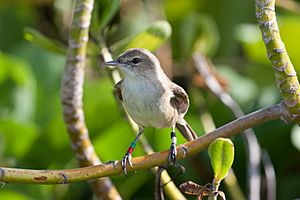Millerbird facts for kids
Quick facts for kids Millerbird |
|
|---|---|
 |
|
| At Laysan, Northwestern Hawaiian Islands, USA | |
| Conservation status | |
| Scientific classification | |
| Genus: |
Acrocephalus (bird)
|
| Species: |
familiaris
|
| Subspecies | |
 |
|
The millerbird (Acrocephalus familiaris) is a small bird that lives only in the Hawaiian Islands. It belongs to a group of birds called Old World warblers. These birds are known for their beautiful songs.
Contents
What is a Millerbird?
The millerbird is a type of warbler. It is the only warbler from the "Old World" (Europe, Asia, Africa) that made its home in Hawaiʻi. Scientists have not found any fossils of millerbirds outside of these islands. This means they have likely always lived only in Hawaiʻi.
Millerbird Subspecies
There are two types, or subspecies, of the millerbird:
- A. f. kingi
- A. f. familiaris
Sadly, one of these, the Laysan millerbird (A. f. familiaris), is now extinct. It disappeared between 1916 and 1923. The other subspecies, the Nihoa millerbird (A. f. kingi), is still alive. However, it is critically endangered, meaning it is at high risk of becoming extinct.
Where Do Millerbirds Live?
The Nihoa millerbird originally lived only on the tiny island of Nihoa in Hawaiʻi. To help save the species, some Nihoa millerbirds have been moved to Laysan island. This gives them another safe place to live and grow their population.
Millerbird Behavior and Reproduction
Millerbirds are known to form strong pair bonds. This means a male and female bird will stay together for a long time. They also protect their territories for many years. A territory is the area where they live and find food.
Millerbird Territories
Their territories can be quite large, up to about 0.95 hectares (2.3 acres). But usually, a territory is smaller, around 0.19 to 0.40 hectares (0.47 to 0.99 acres).
When Do Millerbirds Breed?
Millerbirds can breed at different times of the year. They usually lay eggs and raise their young between January and September. The exact timing depends on how much food is available for them.
How to Identify a Millerbird
The millerbird is a small warbler. You can only find it on Nihoa and Laysan islands in the Northwestern Hawaiian Islands. It is easy to tell apart from other birds on these islands because the only other small birds there are finches. Millerbirds do not live on the main Hawaiian Islands.
Where to Find Them
Millerbirds prefer to live in thick, low plants. They are often hard to see because they are quite secretive. However, male millerbirds sometimes sing from a high spot where they can be seen.
Millerbird Sounds
Their song and calls are described as harsh chirps and churring sounds. Listening for these sounds can help you find a millerbird.



